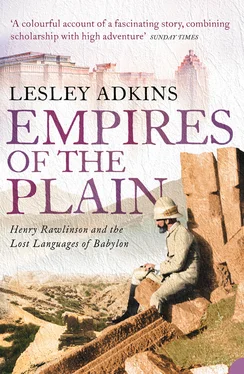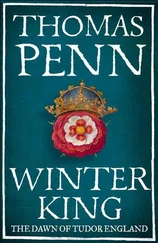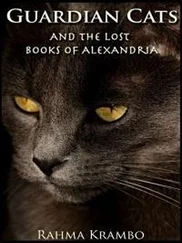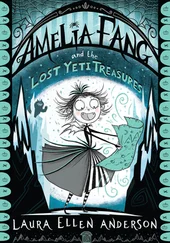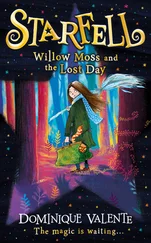Unlike Egyptian hieroglyphs, cuneiform was not a single system of writing representing just one language – it was used for numerous languages over 3,000 years and varied from language to language. Three languages were present in the Bisitun inscription – Old Persian, Elamite and Babylonian. Although it was the Babylonian that Rawlinson failed to copy on this occasion, at the risk of his life he had obtained the full Old Persian and Elamite texts: over 650 lines of cuneiform signs written in eight columns. He not only had the dedication and skill to copy the inscription, but he also possessed the linguistic abilities to tackle the decipherment, impelled by an unquenchable thirst for knowledge of history and ancient geography and a driving ambition to be first in anything he undertook.
Having copied parts of the Old Persian inscription on previous occasions, Rawlinson had already made significant progress in the decipherment of that particular script and language and now knew what Darius had written at Bisitun. On his return to Baghdad, Rawlinson forged ahead with unravelling Babylonian, his ambition now further fuelled by competition from an increasing number of rivals. This was a critical time, because the mounds of Mesopotamia, once ancient cities, were just starting to be explored, with exciting discoveries of palaces filled with astonishing finds. Rawlinson was in a prime position to examine the cuneiform inscriptions covering the relief sculptures and colossal statues, as well as the thousands of cuneiform tablets that had belonged to the palace libraries.
Following in Rawlinson’s footsteps, other cuneiform scripts have since been successfully deciphered, and it is now known that cuneiform was used within an area of at least 600,000 square miles for writing documents as diverse as diplomatic correspondence, accounts, mathematics, legal contracts, astronomy and astrology, as well as history, medicine, magic and religion, epic stories and political propaganda. The decipherment of cuneiform literally revealed a completely undiscovered and unsuspected dimension of the ancient world, not only betraying the long-forgotten secrets of cities like Babylon, Nineveh and Nimrud, but other civilizations whose very names had been lost long ago.
A few days before Henry Creswicke Rawlinson’s fifth birthday, he watched the Royal Scots Greys in their magnificent dress uniforms marching out of Bristol. Reputedly the finest cavalry in Europe, though few had seen active service, these troops and their splendid grey horses were heading from their winter quarters to fame and glory at the Battle of Waterloo, where Napoleon Bonaparte was defeated on 18 June 1815. Many of them would not return from the slaughter. The sight of the cavalry parading down the steep hill of Park Street in Bristol was Rawlinson’s earliest distinct memory – and perhaps his first encouragement to be a horseman and a soldier.
Nearly five years earlier, despite the chill of gloomy, showery spring weather, Wednesday 11 April 1810 had been a day of rejoicing for Abram and Eliza Rawlinson, when their second son was born at Chadlington in north Oxfordshire. Henry’s birth came at a time of continuing upheaval and worry in Europe. That same month Napoleon’s troops began to annex Holland, and the Emperor himself married Marie-Louise, Archduchess of Austria, while France headed towards deep economic crisis. As the year wore on, the Napoleonic Wars were concentrated in Spain and Portugal, where the British troops fought the French under the command of Wellington. In Britain King George III’s mental condition deteriorated, and the following year he was declared insane; his son the Prince of Wales, the future George IV, ruled in his stead as the Prince Regent.
The Rawlinson family had already grown many branches, but their roots were in Lancashire in northern England – respectable but hardly noteworthy members of the gentry, who owned land mainly in the isolated Furness area. The derivation of the surname remains uncertain, possibly ‘son of Roland’, as in the associated surnames Rowlinson and Rollinson, yet these names occur in Lancashire only from the sixteenth century, decades later than Rawlinson. One of Henry’s ancestors was Daniel Rawlinson, a wealthy London vintner, tea merchant and keeper of the Mitre Tavern in Fenchurch Street, much frequented by his friend and neighbour Samuel Pepys until its destruction in the Great Fire of 1666. Daniel’s son Sir Thomas Rawlinson, who inherited his estates and businesses, was Lord Mayor of London in 1705–6. His own eldest son Thomas developed a passion for books and manuscripts, amassing over 50,000 volumes and 1,000 manuscripts that were eventually sold to settle his debts. This unpalatable task was forced upon his younger brother Richard, himself a book collector and antiquary, who in 1750 set up an endowment for a professorship of Anglo-Saxon at Oxford University. Now called the Rawlinson and Bosworth Chair of Anglo-Saxon, its most notable incumbent was J. R. R. Tolkien. Another Anglo-Saxon scholar was Henry’s ancestor Christopher Rawlinson, born in 1677, who is most famous for having prepared and published an Anglo-Saxon edition of King Alfred’s translation of Boethius’s Consolation of Philosophy.
Although Henry was not directly descended from Daniel and Christopher, they could all trace their roots back to two brothers, William and John, in the reign of Henry VIII. Earlier still the family tree lacks detail, but ancestors certainly served at the Battle of Agincourt in 1415 under Henry V, who awarded the Rawlinson coat-of-arms that has three silver-bladed swords with gold hilts on a sable ground, and for the crest a lower arm sheathed in armour, with the hand grasping a sword. Henry’s own father, Abram Tyzack Rawlinson, was the elder of the twin sons of Henry Rawlinson, a merchant and Member of Parliament for Liverpool who married a Newcastle upon Tyne heiress, Martha Tyzack. The twins’ father died in 1786 when they were nine years old, but they continued to live at Caton near Lancaster, in the ancestral home of Grassyard (now Gresgarth) Hall. Here Abram and his twin Henry Lindow were raised by their mother and subsequently educated at Rugby School and Christ Church, Oxford, where they concentrated on sporting, not educational attainment. On inheriting Grassyard Hall and its estate, Abram promptly sold up and began to look for an estate ‘in the more civilised part of England’, 1 having come to despise northern England ‘for its roughness, its coarseness, and its “savagery”’. 2 In August 1800 at St George’s Church in Hanover Square, London, he married Eliza Eudocia Albinia Creswicke, who had inherited the enormous sum of £20,000 from her deceased brother Henry.
Six years after his marriage to Eliza, Abram bought a 700-acre agricultural estate at Chadlington, an ancient pre-Domesday village just south of Chipping Norton and 13 miles north-west of Oxford – close to his wife’s former home at Moreton-in-Marsh. The spacious L-shaped manor house at Chadlington, where Henry Creswicke Rawlinson was born and spent his childhood, was built of Cotswold stone and was separated from the medieval church of St Nicholas and the village to the north by a belt of trees, while in front was a lawn terrace, a ha-ha and a hay meadow. The extensive view across the Evenlode Valley first took in clumps of elms and oaks in the meadow, with fields and copses beyond as far as the river, while the extensive Wychwood forest covered the hillside in the distance. It was a perfect place to live.
For much of the day Abram rode from field to field, watching over the running of his largely arable farm, talking to the labourers and discussing business matters with his bailiff. The months of September and October were occupied by shooting and the rest of the autumn and winter by riding with the Duke of Beaufort’s hunt. Another of Abram’s passions was the breeding and training of racehorses, in which he had several successes, and he was also involved in civic duties as a Justice of the Peace and a Deputy-Lieutenant of Oxfordshire.
Читать дальше
